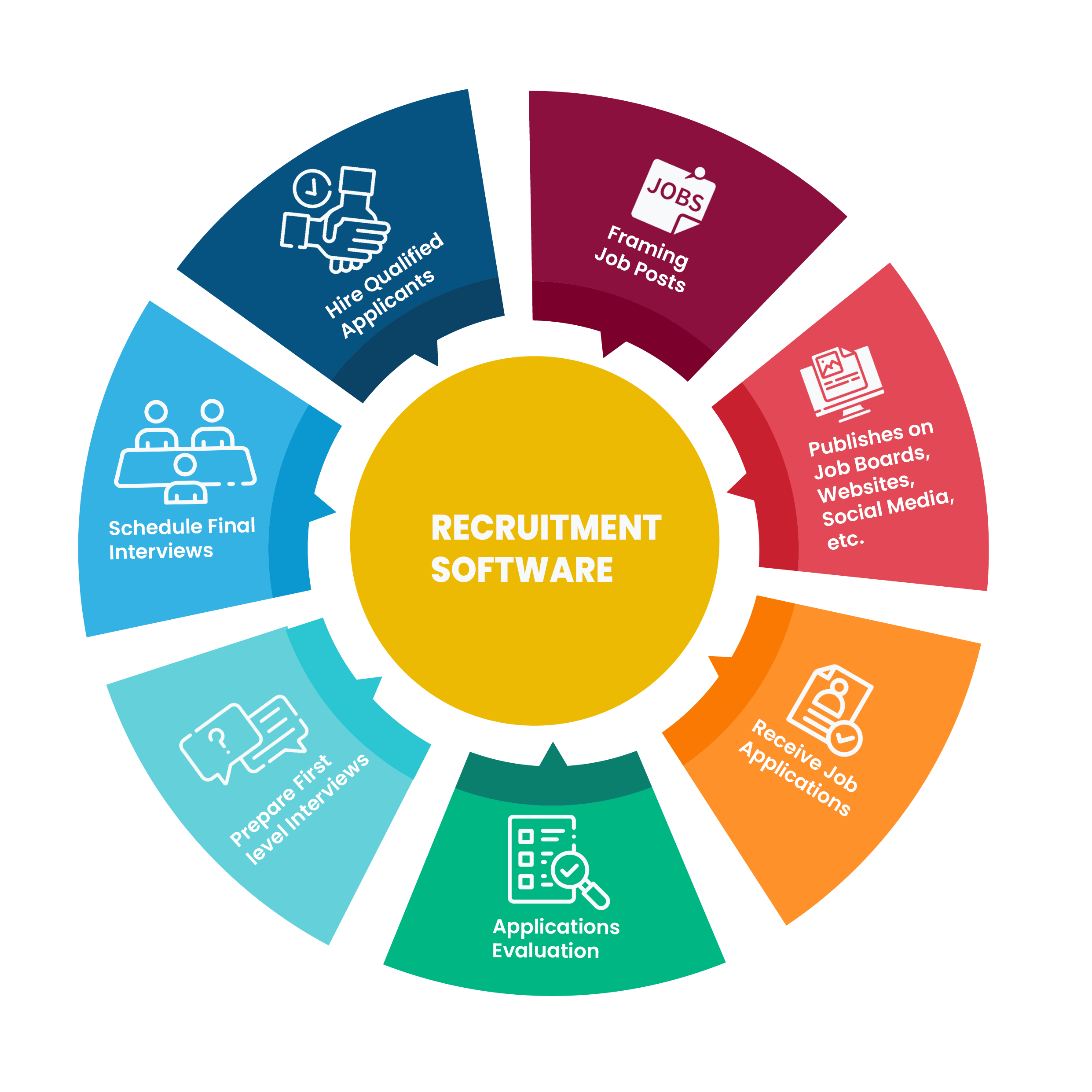Introduction: Transforming Talent Acquisition in the Digital Age
The traditional landscape of talent acquisition, characterized by physical job boards and resume piles, is undergoing a paradigm shift driven by the unstoppable force of digital technology. This digital transformation, often referred to as recruitment technology (recruitment tech), is revolutionizing the way organizations attract, engage, and hire top talent. This introduction delves into the pivotal role of Recruiter Web Applications in this exciting new era, highlighting their contribution to streamlining processes, enhancing efficiency, and ultimately, transforming talent acquisition.
Unveiling the Evolution of Recruitment Processes:
Historically, recruitment processes were labor-intensive and time-consuming. Tasks like sourcing candidates, screening resumes, and scheduling interviews involved manual effort and limited scope. However, the digital revolution has introduced a plethora of innovative tools and technologies, transforming the recruitment landscape:
- Candidate Relationship Management (CRM) Systems: Organize and manage interactions with potential and existing candidates, fostering relationships and building talent pools.
- Job Boards and Applicant Tracking Systems (ATS): Streamline job posting, application management, and resume screening, facilitating efficient candidate sourcing and initial filtering.
- Social Media Recruiting: Leverage professional networking platforms and social media to expand reach, target specific demographics, and engage with potential talent in new ways.
- Video Interviews and Assessments: Conduct virtual interviews and online assessments, offering time and cost-effective solutions for candidate evaluation, particularly for geographically dispersed talent pools.
These innovations have significantly improved the efficiency and reach of talent acquisition efforts. However, integrating these various tools into a cohesive and user-friendly platform is crucial for maximizing their effectiveness. This is where Recruiter Web Applications emerge as powerful tools for both recruiters and candidates.
The Pivotal Role of Recruiter Web Applications:
Recruiter Web Applications offer a comprehensive suite of functionalities designed to streamline the entire recruitment process, from initial sourcing to onboarding. These platforms offer numerous benefits for both recruiters and candidates:
Benefits for Recruiters:
- Centralized platform: Streamline all recruitment activities, manage candidate information, and automate workflows within a single, user-friendly platform.
- Improved efficiency: Automate repetitive tasks like screening resumes and scheduling interviews, freeing up valuable time for recruiters to focus on strategic initiatives.
- Enhanced candidate experience: Offer candidates a user-friendly platform to apply for jobs, track their application status, and communicate with recruiters, fostering a positive candidate experience.
- Data-driven decision-making: Gain access to valuable insights and analytics, allowing recruiters to identify trends, assess recruitment effectiveness, and make data-driven hiring decisions.
Benefits for Candidates:
- Simplified job search: Easily search for open positions, apply online, and manage applications in a centralized location.
- Transparent communication: Track application status, receive updates from recruiters, and schedule interviews conveniently.
- Improved user experience: Access relevant company information, company culture insights, and career resources, allowing for informed decision-making throughout the application process.
By leveraging Recruiter Web Applications, organizations can attract a wider pool of qualified candidates, improve the efficiency of their recruitment process, and ultimately, build a stronger talent pipeline. This transformation fosters a more efficient and effective talent acquisition strategy, allowing organizations to compete effectively in the ever-evolving job market.
In conclusion, Recruiter Web Applications play a critical role in shaping the future of talent acquisition. These platforms empower both recruiters and candidates, enabling a more efficient, streamlined, and transparent recruitment experience. As technology continues to evolve and these applications become increasingly sophisticated, we can expect even more innovative functionalities and advancements shaping the future of talent acquisition in the digital age.

Navigating the Recruitment Landscape: The Power of Recruiter Web Applications
Recruiter Web Applications are not merely digital tools; they are catalysts for a paradigm shift in talent acquisition. This section delves into their potential to redefine candidate sourcing and management, while simultaneously empowering the creation of personalized recruitment campaigns that resonate with diverse talent pools.
Seamless Candidate Sourcing and Management:
- Redefining Candidate Sourcing through Intelligent Algorithms:
Traditional sourcing methods often involved relying on job boards or personal networks, limiting the reach and diversity of the candidate pool. Recruiter Web Applications leverage the power of intelligent algorithms to:
- Proactive sourcing: Utilize advanced algorithms to search online platforms, professional networks, and niche talent pools, identifying qualified candidates beyond traditional sources.
- Skills-based matching: Match candidate skills and experience with specific job requirements, ensuring a more relevant and targeted talent pool.
- Passive candidate identification: Identify and engage with “passive candidates” who are not actively searching for new opportunities but possess relevant skills and experience.
These features expand the scope of candidate sourcing, allowing recruiters to reach a wider range of qualified individuals, and ultimately, build stronger talent pipelines.
- Streamlining Candidate Management for Recruiters:
Managing the influx of applications and candidate information can be overwhelming. Recruiter Web Applications offer functionalities to:
- Centralized candidate database: Store and manage all candidate information, including resumes, applications, and communication history, in a central and easily accessible location.
- Automated workflows: Automate repetitive tasks like sending initial communication emails, scheduling interviews, and gathering feedback, freeing up valuable recruiter time.
- Collaboration tools: Facilitate collaboration among internal teams involved in the hiring process, enabling seamless communication and efficient decision-making.
These functionalities streamline the entire recruitment process, allowing recruiters to focus on building relationships with potential candidates, conducting insightful interviews, and making informed hiring decisions.
Personalized Recruitment Campaigns:
- Crafting Tailored Recruitment Campaigns for Diverse Roles:
A “one-size-fits-all” approach to recruitment is no longer effective. Recruiter Web Applications empower the creation of personalized recruitment campaigns by:
- Job description customization: Tailor job descriptions to specific roles and company culture, highlighting relevant skills, experience, and company values to attract the right candidates.
- Targeted outreach: Utilize various communication channels, such as email, social media, and professional networking platforms, to reach specific demographics and talent pools relevant to the position.
- Employer branding promotion: Showcase the company culture, employee testimonials, and career growth opportunities through integrated branding tools, attracting candidates who align with the company’s values and aspirations.
By personalizing campaigns, organizations can attract more suitable candidates, increase application rates, and build a strong employer brand that resonates with diverse talent pools.
- Leveraging Data-Driven Insights for Campaign Optimization:
Recruiter Web Applications provide valuable data and analytics to help organizations optimize their recruitment strategies. These insights include:
- Candidate source effectiveness: Identify the most effective channels for sourcing qualified candidates, allowing for targeted resource allocation and campaign optimization.
- Application funnel analysis: Analyze the application process at different stages, identifying drop-off points and areas for improvement, such as application form complexity or unclear job descriptions.
- Candidate engagement metrics: Track candidate engagement throughout the process, including email open rates, website visits, and time spent on applications, providing insights into candidate interest and experience.
By analyzing this data and interpreting key metrics, organizations can continuously improve their recruitment campaigns, attract top talent, and build a competitive edge in the job market.
In conclusion, Recruiter Web Applications empower a more efficient and personalized approach to talent acquisition. By leveraging intelligent algorithms for candidate sourcing, streamlining management processes, and crafting personalized recruitment campaigns, these platforms empower organizations to build strong talent pipelines and attract the best candidates for their open positions. As technology continues to evolve and these applications become more sophisticated, we can expect even more innovative functionalities and advancements shaping the future of talent acquisition.
The Heart of Recruitment: Enhancing the Hiring Process

Recruiter Web Applications extend their impact beyond candidate sourcing and management, playing a vital role in optimizing the very core of recruitment – the hiring process. This section explores how these applications empower organizations with functionalities for dynamic Applicant Tracking System (ATS) integration, automated resume screening and skill matching, and collaborative hiring practices.
Dynamic Applicant Tracking System (ATS) Integration:
- Maximizing Efficiency with a Dynamic ATS:
An Applicant Tracking System (ATS) is a software solution that streamlines the recruitment process by managing applications, scheduling interviews, and facilitating communication. Recruiter Web Applications seamlessly integrate with various ATS solutions, offering:
- Centralized data management: Eliminate data silos by integrating candidate information from the web application directly into the ATS, ensuring a unified and accessible data repository.
- Automated workflows: Leverage the combined functionalities of both platforms to automate repetitive tasks like sending interview invitations, collecting feedback, and managing candidate statuses, saving recruiters valuable time and effort.
- Customizable dashboards and reporting: Generate reports and access real-time data on key recruitment metrics, such as time-to-hire and application sources, providing valuable insights for informed decision-making.
This dynamic integration streamlines the hiring process, improves operational efficiency, and empowers recruiters to focus on strategic aspects of talent acquisition.
- Ensuring a User-Friendly Experience for Recruiters and Candidates:
A user-friendly experience is crucial for both recruiters and candidates throughout the hiring process. Recruiter Web Applications integrated with ATS systems should prioritize:
- Intuitive interface: Design an interface that is easy to navigate and understand for users with varying levels of technical expertise.
- Mobile-friendly design: Ensure the platform is accessible and user-friendly on mobile devices, catering to the growing trend of mobile job searching and application management.
- Clear communication tools: Facilitate clear and timely communication between recruiters and candidates throughout the process, fostering transparency and building trust.
By prioritizing a user-friendly experience, organizations can attract and retain top talent, while ensuring a smooth and efficient hiring process for all stakeholders involved.
Automated Resume Screening and Skill Matching:
- Harnessing Automation for Quick and Accurate Resume Screening:
Traditionally, screening resumes can be a time-consuming and tedious task. Recruiter Web Applications leverage automation to:
- Keyword extraction: Extract relevant keywords and skills from resumes, aligning them with job description requirements for initial filtering and identification of qualified candidates.
- Automated resume scoring: Utilize pre-defined criteria and machine learning algorithms to score resumes based on skills, experience, and other relevant factors, assisting recruiters in prioritizing candidates for further review.
- Flagging potential red flags: Identify potential inconsistencies or red flags in resumes, such as resume gaps or unverifiable information, allowing recruiters to focus their attention on qualified candidates.
These automated features expedite the screening process, reduce bias, and allow recruiters to prioritize candidates who best match the specific requirements of the open position.
- Matching Candidates with the Right Skills through Intelligent Algorithms:
Beyond resume screening, Recruiter Web Applications utilize intelligent algorithms for skill matching:
- Matching skills to job requirements: Analyze candidate skills and experience against the job description, identifying individuals with the most relevant qualifications and skill sets.
- Matching candidates to company culture: Consider factors like cultural fit and soft skills beyond technical expertise, fostering the creation of diverse and well-rounded teams.
- Recommending similar candidates: Based on the analysis of a pool of applicants, recommend similar candidates with relevant skills and experience, expanding the talent pool for consideration.
By leveraging intelligent skill matching, organizations can identify and attract candidates who are not only technically qualified but also culturally aligned with the company’s values and work environment.
Collaborative Hiring: Facilitating Team Coordination:
- Empowering Collaborative Decision-Making in the Hiring Process:
The hiring process often involves multiple stakeholders, including recruiters, hiring managers, and team members. Recruiter Web Applications foster collaborative hiring by:
- Centralized communication platform: Provide a platform for all stakeholders involved in the hiring process to communicate, share feedback, and collaborate seamlessly.
- Real-time candidate profiles: Offer a centralized location to access and update candidate information, interview notes, and feedback, ensuring everyone involved has access to the latest information.
- Scheduling and feedback tools: Facilitate easy scheduling of interviews and streamlined collection of feedback from various team members, ensuring efficient and transparent decision-making.
These functionalities empower a collaborative hiring approach, allowing teams to leverage diverse perspectives and make informed decisions when selecting the best candidate for the role.
- Integrating Feedback Loops for Efficient Team Coordination:
Effective communication and feedback are crucial for collaborative hiring. Recruiter Web Applications empower these aspects by:
- Integrated feedback forms and surveys: Provide standardized feedback forms for interviews and assessments, allowing team members to easily share their insights and evaluations.
- Feedback sharing and discussion tools: Facilitate the sharing of feedback with relevant stakeholders and provide space for discussion and clarification, ensuring all perspectives are considered.
- Actionable feedback reports: Generate reports that summarize key insights and recommendations from various team members, providing valuable information for informed decision-making.
By integrating these feedback loops, organizations can ensure transparent and efficient communication throughout the hiring process, leading to better-informed decisions and the selection of the most qualified candidates.
In conclusion, Recruiter Web Applications significantly enhance the core of recruitment – the hiring process. From integrating dynamic ATS systems to leveraging automation and fostering collaborative hiring, these platforms empower organizations to optimize their recruitment strategies, attract top talent, and build strong and diverse teams. As technology continues to evolve, we can expect even more innovative functionalities and advancements shaping the future of talent acquisition.
Tech Marvels: Cutting-Edge Features of Recruiter Web Applications
Recruiter Web Applications are not merely tools for automation; they are innovation hubs constantly evolving with cutting-edge features that further revolutionize talent acquisition. This section explores two such advancements: Artificial Intelligence (AI) and blockchain technology.

Artificial Intelligence in Recruitment:
- AI-driven Insights for Strategic Talent Acquisition:
AI algorithms are transforming recruitment by providing data-driven insights to fuel strategic decision-making:
- Predictive analytics: Analyze historical hiring data and candidate profiles to predict potential candidate success and identify high-potential individuals.
- Market trend analysis: Utilize AI to analyze job market trends, identify emerging talent pools, and adapt recruitment strategies to changing demographics and skill demands.
- Resume analysis beyond keywords: Go beyond simple keyword matching and analyze resumes for nuanced language and writing styles, potentially uncovering hidden talents and cultural alignment.
These AI-powered features empower organizations to move beyond traditional recruitment methods, identify exceptional talent, and build future-proof talent pipelines.
- Chatbot Assistance in Candidate Interactions:
Chatbots powered by AI are transforming candidate communication:
- 24/7 availability: Respond to basic candidate inquiries, answer frequently asked questions, and schedule initial interviews, freeing up recruiters for more strategic tasks.
- Personalized candidate experience: Tailor chatbot interactions based on specific roles and candidate profiles, providing a more personalized and engaging experience.
- Candidate screening and qualification: Utilize chatbots for pre-screening questions and basic skills assessments, streamlining the initial stages of the recruitment process.
By incorporating chatbots, organizations can improve candidate experience, ensure efficient communication, and free up valuable recruiter time.
Blockchain in Background Verification:
- Ensuring Secure and Transparent Background Verification Processes:
Blockchain technology offers immense potential for secure and transparent background verification:
- Immutable data storage: Securely store and share candidate information on a decentralized blockchain, ensuring data integrity and preventing unauthorized modifications.
- Streamlined verification process: Facilitate faster and more efficient verification by connecting with various institutions and verifying information directly on the blockchain.
- Enhanced candidate control: Empower candidates to control their data access and share it securely with potential employers, fostering trust and transparency.
- By integrating blockchain, organizations can streamline background checks, ensure data security, and build trust with potential candidates.
In conclusion, AI and blockchain technologies are revolutionizing Recruiter Web Applications, offering innovative functionalities that enhance efficiency, transparency, and the overall recruitment experience. As these technologies continue to evolve and integrate further, we can expect even more exciting advancements shaping the future of talent acquisition.
Addressing Challenges: Innovative Solutions in Recruiter Web Application Development

Despite their immense potential, Recruiter Web Applications are not without their challenges. This section explores two crucial areas: fostering diversity and inclusion in recruitment and adapting to ever-changing market trends. We will further discuss innovative solutions embedded within these applications to address these challenges effectively.
Diversity and Inclusion: Navigating Recruitment Challenges:
- Strategies for fostering diversity and inclusion in hiring:
Recruiting a diverse and inclusive workforce is crucial for any organization striving for success. Recruiter Web Applications can contribute by:
- Blind resume review: Allow recruiters to review resumes without identifying information like names or universities, reducing the potential for unconscious bias based on demographics.
- Skill-based assessments: Utilize standardized skills assessments that focus on objective criteria rather than subjective evaluations based on resumes or personal experiences.
- Diverse talent pool targeting: Integrate with job boards and platforms catering to diverse demographics, expanding the reach beyond traditional channels and attracting potentially overlooked talent pools.
These strategies, embedded within the applications, can help mitigate biases and create a more level playing field for all candidates, fostering greater diversity and inclusion in the hiring process.
- Tools and features to mitigate biases in the recruitment process:
In addition to strategic approaches, Recruiter Web Applications are incorporating specific tools to address bias:
- AI bias detection: Utilize AI algorithms to identify instances of potential bias in job descriptions, interview questions, or even resume language, allowing for course correction and ensuring fair evaluation of all candidates.
- Diversity dashboards and analytics: Track diversity metrics throughout the recruitment process, identifying potential areas for improvement and ensuring equitable hiring practices are followed consistently.
- Anonymous feedback mechanisms: Allow candidates to provide anonymous feedback on their recruitment experience, enabling organizations to identify and address potential biases within their processes.
These tools empower organizations to identify and address potential biases proactively, leading to a fairer and more inclusive recruitment experience for all.
Adaptability to Changing Market Trends:
- Staying ahead by adapting to dynamic market trends:
The recruitment landscape is constantly evolving, with emerging technologies, skills, and job demands. Recruiter Web Applications need to be adaptable to these changes:
- Real-time market data integration: Integrate with platforms and services that provide real-time data on market trends, skills in demand, and emerging technologies, allowing organizations to adapt their recruitment strategies accordingly.
- Flexible job description tools: Offer tools to create and update job descriptions easily, allowing for quick adjustments based on evolving skills requirements and market dynamics.
- Scalable and modular architecture: Design the application with a modular architecture that allows for easy integration of future features and functionalities, ensuring adaptability as technology and market demands change.
By prioritizing adaptability, Recruiter Web Applications can help organizations stay ahead of the curve, attract the best talent in the evolving job market, and maintain a competitive edge in the long run.
- Utilizing flexible features for evolving recruitment needs:
Recruiting needs can vary significantly across different industries and even within organizations. Recruiter Web Applications cater to this by offering flexible features:
- Configurable workflows: Allow organizations to customize the recruitment process and workflows based on their specific needs and company culture.
- Integrations with diverse tools: Integrate with a variety of HR and recruitment tools, enabling organizations to leverage their existing technology landscape and tailor their recruitment process accordingly.
- Customizable dashboards and reporting: Provide customizable dashboards and reports to track key recruitment metrics, allowing organizations to gain valuable insights and adapt their strategies based on evolving needs.
These functionalities empower organizations to tailor their recruitment processes to their specific needs, ensuring efficiency and effectiveness in attracting and hiring the best talent, regardless of market fluctuations.
In conclusion, Recruiter Web Applications are powerful tools for transforming talent acquisition, but challenges remain. By prioritizing diversity and inclusion, and adapting to changing market trends, these applications can be further enhanced with innovative solutions. By incorporating tools and features that mitigate biases and offer adaptability, Recruiter Web Applications can empower organizations to build diverse and future-proof workforces, paving the way for a more inclusive and dynamic future of talent acquisition.
Success Stories: Exemplary Cases of Recruiter Web Application Impact

Recruiter Web Applications are not just theoretical concepts; they are driving real-world success stories. Here, we explore the impact of two leading platforms: LinkedIn Recruiter and Greenhouse.
LinkedIn Recruiter: Shaping the Professional Landscape:
- Examining LinkedIn Recruiter’s influence on professional networking:
LinkedIn Recruiter has revolutionized professional networking by:
- Expanding reach: Providing access to a vast network of professionals, allowing recruiters to target specific talent pools and connect with passive candidates.
- Enhanced targeting and communication: Utilizing advanced search filters and personalized messaging tools to reach the right candidates with the right opportunities.
- Data-driven insights: Offering valuable data and analytics on candidate profiles and hiring trends, enabling recruiters to make informed decisions throughout the recruitment process.
- Key takeaways for successful implementation in recruitment:
The success of LinkedIn Recruiter highlights the importance of:
- Strategic talent pool identification: Utilizing advanced search and filtering features to identify and target the most relevant talent pools.
- Personalized outreach and communication: Building relationships with potential candidates through personalized messages and engaging interactions.
- Data-driven decision-making: Leveraging data and analytics to inform hiring decisions and optimize the recruitment strategy.
By following these principles, organizations can leverage LinkedIn Recruiter to tap into a wider talent pool, build meaningful candidate relationships, and achieve successful recruitment outcomes.
Greenhouse: Cultivating Efficient Hiring Processes:
- Analyzing Greenhouse’s role in optimizing hiring workflows:
Greenhouse has transformed recruitment through:
- Streamlined workflows: Automating repetitive tasks, managing candidate information efficiently, and facilitating collaboration between hiring teams.
- Improved candidate experience: Providing candidates with a user-friendly platform to apply for jobs, track their application status, and communicate with recruiters.
- Data-driven insights and reporting: Offering valuable data on hiring metrics, allowing organizations to identify areas for improvement and optimize their recruitment strategies.
- Insights into improved candidate experiences and recruitment outcomes:
Greenhouse’s success underscores the significance of:
- Streamlining the application process: Removing unnecessary steps and creating a user-friendly experience for candidates, leading to increased application rates and improved candidate satisfaction.
- Data-driven decision-making: Utilizing data to analyze hiring trends, identify bottlenecks, and continuously improve the recruitment process.
- Building a strong employer brand: Leveraging the platform to showcase company culture and career opportunities, attracting top talent and fostering a positive candidate experience.
By implementing Greenhouse effectively, organizations can attract top talent, improve the candidate experience, and ultimately, achieve successful recruitment outcomes.
These success stories demonstrate the transformative potential of Recruiter Web Applications. By leveraging these powerful platforms and adhering to best practices, organizations can build stronger talent pipelines, improve recruitment efficiency, and create a more positive and inclusive hiring experience for all.
Future Visions: Trends Shaping the Future of Recruiter Web Applications

The future of Recruiter Web Applications is brimming with exciting possibilities. As technology continues to evolve, we can expect to see:
- Augmented Reality (AR) integration: AR could revolutionize interviews by allowing candidates to experience virtual work environments, fostering a deeper understanding of the role and company culture.
- Predictive analytics and AI-powered talent matching: Advanced algorithms will analyze vast datasets to identify potential candidates with high success potential and recommend ideal candidates based on skills, experience, and cultural fit.
- Enhanced candidate engagement: Gamification and interactive elements will be incorporated to make the application process more engaging and enjoyable for candidates, leading to increased participation and better candidate experiences.
- Focus on ethical considerations: As AI plays a larger role in recruitment, developers and organizations will prioritize ethical considerations, ensuring fairness, transparency, and responsible use of technology throughout the hiring process.
These advancements promise to further revolutionize recruitment, **optimizing efficiency, fostering innovation, and ultimately, creating a more dynamic and inclusive future of talent acquisition.
Conclusion
In the grand tapestry of talent acquisition, Recruiter Web Applications emerge as the brushstrokes reshaping the canvas of recruitment. This digital evolution transcends traditional paradigms, offering a dynamic and efficient approach to acquiring top-tier talent.
Recruiter Web Applications seamlessly blend advanced technologies—AI-driven insights, blockchain security, and personalized campaigns—revolutionizing how organizations attract, assess, and onboard candidates. As we conclude this exploration, it’s evident that these applications are not mere tools; they are architects of a new era in recruitment.
Embrace the transformative power of Recruiter Web Applications—where diversity thrives, biases diminish, and hiring becomes a strategic pursuit. The future of talent acquisition is now, and those who leverage these innovations are not just recruiting; they are defining the future workforce. Here’s to a recruitment landscape redefined, where every click propels organizations towards unparalleled success in talent acquisition.









